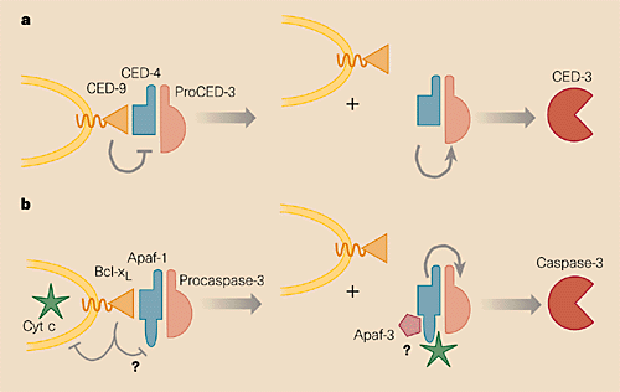
- Select a language for the TTS:
- UK English Female
- UK English Male
- US English Female
- US English Male
- Australian Female
- Australian Male
- Language selected: (auto detect) - EN
Play all audios:
Access through your institution Buy or subscribe The nematode worm _Caenorhabditis elegans_ has been used with great success to identify the basic components of the machinery underlying
apoptosis (programmed cell death)1. Indeed, of the three key cell death genes that have been identified in _C. elegans_, two – _ced-3_ and _ced-9_ – have mammalian homologues that also
function in apoptosis. But the sequence of the third gene, _ced-4_, revealed no obvious mammalian homologue, and precious little in terms of possible mechanism of action. A flurry of
activity has changed that. A paper by Zou _et al_., published earlier this month in _Cell_2, provides a homologue. And work by Chinnaiyan _et al_. (page 728of this issue3) and by Seshagiri
and Miller in _Current Biology_4 lays down some choreography for the part that CED-4 protein plays in the molecular dance of death. Over the years, genetic screens in _C. elegans_ have led
to the identification of about a dozen cell death (_ced_) genes that are responsible for one aspect or another of the apoptotic process. Three of these genes stand out. Two, _ced-3_ and
_ced-4_, are essential for cell death. The third, _ced-9_, antagonizes the proapoptotic activities of _ced-3_ and _ced-4_, and thereby protects cells that should survive from any accidental
activation of the death programme. This is a preview of subscription content, access via your institution ACCESS OPTIONS Access through your institution Subscribe to this journal Receive 51
print issues and online access $199.00 per year only $3.90 per issue Learn more Buy this article * Purchase on SpringerLink * Instant access to full article PDF Buy now Prices may be subject
to local taxes which are calculated during checkout ADDITIONAL ACCESS OPTIONS: * Log in * Learn about institutional subscriptions * Read our FAQs * Contact customer support REFERENCES *
Hengartner, M. O. & Horvitz, H. R. _Curr. Opin. Gen. Dev_. 4, 581–586 (1994). Google Scholar * Zou, H., Henzel, W. J., Liu, X., Lutschg, A. & Wang, X. _Cell_ 90, 405–413 (1997).
Google Scholar * Chinnaiyan, A. M., Chaudhary, D., O'Rourke, K., Koonin, E. V. & Dixit, V. M. _Nature_ 388, 728–729 (1997). Article ADS CAS Google Scholar * Seshagiri, S. &
Miller, L. K. _Curr. Biol_. 7, 455–460 (1997). Google Scholar * Shaham, S. & Horvitz, H. R. _Genes Dev_. 10, 578–591 (1996). Google Scholar * Jacobson, M. D. _Curr. Biol_. 7,
R277-R281 (1997). * Reed, J. C. _Nature_ 387, 773–776 (1997). Article ADS CAS Google Scholar * James, C., Gschmeissner, S., Fraser, A. & Evan, G. I. _Curr. Biol_. 7, 246–252 (1997).
Google Scholar * Chinnaiyan, A. M., O'Rourke, K., Lane, B. R. & Dixit, V. M. _Science_ 275, 1122–1126 (1997). Google Scholar * Liu, X., Kim, C. N., Yang, J., Jemmerson, R. &
Wang, X. _Cell_ 86, 147–157 (1996). Google Scholar * Golstein, P. _Science_ 275, 1081–1082 (1997). Google Scholar * Hofmann, K. _et al. Trends Biochem. Sci_. 22, 155–156 (1997). Google
Scholar Download references AUTHOR INFORMATION AUTHORS AND AFFILIATIONS * Cold Spring Harbor Laboratory, 1 Bungtown Road, Cold Spring Harbor, 11724, New York, USA Michael O. Hengartner
Authors * Michael O. Hengartner View author publications You can also search for this author inPubMed Google Scholar RIGHTS AND PERMISSIONS Reprints and permissions ABOUT THIS ARTICLE CITE
THIS ARTICLE Hengartner, M. Apoptosis CED-4 is a stranger no more. _Nature_ 388, 714–715 (1997). https://doi.org/10.1038/41873 Download citation * Issue Date: 21 August 1997 * DOI:
https://doi.org/10.1038/41873 SHARE THIS ARTICLE Anyone you share the following link with will be able to read this content: Get shareable link Sorry, a shareable link is not currently
available for this article. Copy to clipboard Provided by the Springer Nature SharedIt content-sharing initiative




